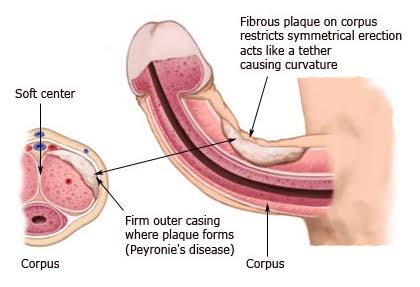Peyronie’s disease is penis problem caused by scar tissue, called plaque, that forms inside the penis. It can result in a bent, rather than straight, erect penis.
Most men with Peyronie’s diseases can still have sex. But for some, it can be painful and cause erectile dysfunction.
Depending on the symptoms, you may opt for observation, medical or surgical treatments.
What are the symptoms of Peyronie’s Disease?
The symptoms and signs of this disease can build up gradually or might suddenly appear in an individual. Some of the common symptoms are as follows:
• Scar tissue: As a result of the accumulation of the scar tissue, a lump or hard tissue can be felt under the skin
• Penis size: Penis can become shorter when a person is facing from this disease
Erection issue: The erection might not last as long as it should
• Penis bent: The penis might bend significantly at an angle
• Pain: There could be a significant pain while erection. As days go by, the pain becomes worse.
Causes of Peyronie’s disease?
While the exact cause of Peyronie’s disease is not known, researchers indicate a variety of factors for this condition:
A repeated penis injury from athletic activity, accident, trauma and damage resulting from sex
If in the process of healing, the scar tissue forms a lump
The improper functioning of corpus cavernosum
In few cases, this disease can occur normally without the involvement of any accident or injury
What are the risk factors?
There could be various factors that put a person at risk of facing this disease:
• Heredity: If someone in the immediate family is facing this disease, it puts a person at increased risk of facing Peyronie’s disease due to heredity.
• Age: With age, the risk potential of this disease increases since the tissue tends to become softer.
• Disorder of the connective tissue: People suffering from connective tissue disorder are at a higher risk of getting this disease. It is often observed that a person who has been diagnosed with Peyronie’s Disease often suffers from a connective tissue disorder known as Dupuytren’s contracture.
Diagnosis and treatment:
A physical exam gives a doctor possible indication about the disease. The patient may be asked to bring the photographs of the penis in erect condition to get an idea about the curvature degree and scar tissue location. He might also prescribe an ultrasonography. The medication depends on the stage of diagnosis. In the early stage, a doctor might recommend a wait and watch approach. He might also prescribe medication to minimize the pain and remove the scar tissue. If medication fails one might have to go undergo a surgery to get a permanent cure. If you wish to discuss about any specific problem, you can consult a Doctor or Sexologist



